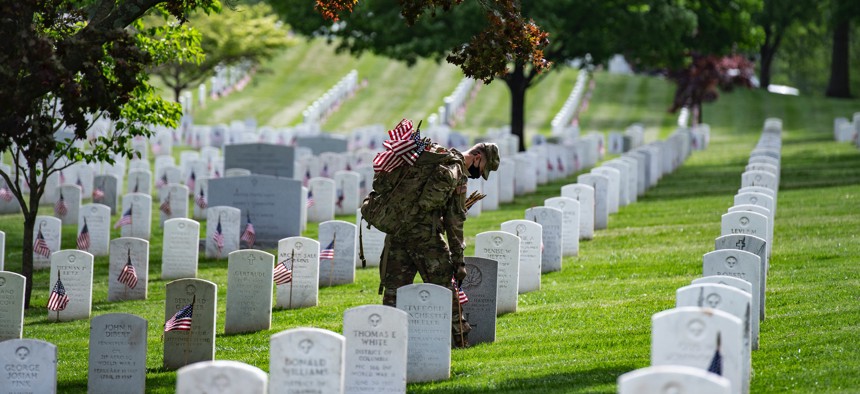
Soldiers assigned to the 3rd U.S. Infantry Regiment, known as “The Old Guard,” place American flags at headstones in Arlington National Cemetery, Arlington, Va., May 21, 2020. Elizabeth Fraser / U.S. Army
A Simple Veterans Day Proposal for the Incoming Administration
Send every political appointee to visit Arlington National Cemetery — with someone who served.
There was a time, not so long ago, when Veterans Day was a personal affair for most Americans. The mass mobilization of World War II, coupled with the draft era of Korea and Vietnam, meant that almost every dinner table was connected to the military, and almost every citizen had a close relationship with someone who had served in uniform.
That time has passed, and it has passed with consequences. Forty-seven years into the all-volunteer force, military veterans make up only seven percent of the population. Many Americans do not know and have not spent any meaningful time with a service member. It’s a fact for the man on the street, and it’s a fact for many of the women and men who walk the halls of American power.
We are about to see a change in who walks those halls. The challenges facing the incoming administration are enormous, made even more complicated by a raging pandemic and a toxic and divided political culture. In the face of these daunting issues, I propose a small idea, one that won’t resolve any of major policy disputes, but that might affect the environment in which they are considered.
What if every new Biden-Harris appointee was asked to go to Arlington National Cemetery and to walk the grounds with a member of the military, a veteran, or a military family member? Not just the appointees serving in national security or Veterans Affairs posts, but every appointee, from every department, from cabinet secretaries to policy experts to confidential assistants across the interagency.
It is a simple act, but an important one. I never served in the military, but I was lucky to spend time in the company of those who did. Growing up an Army brat, and later working as political appointee in the Pentagon, shaped my sense of service, my understanding of sacrifice, and my relationship to the concept of public-policy consequences. It made me better at what I did.
One afternoon can’t replicate those connections, but it can start to change perceptions. During my time in government, I often found myself visiting Arlington, and was surprised by how few of my colleagues had ever been. It was only a couple Metro stops away from their offices, but it was a world away from many of their life experiences.
These would be quiet visits, opportunities to listen. They shouldn’t be viewed as partisan—it just happens that the President-elect is a Democrat—and the offer to participate could be extended to incoming members of Congress and their staffs.
This could be a starting point for a national commitment to directly connect, in small ways, the American people to the military that defends them. For all the talk in policy circles about the growing civ-mil divide, sometimes the simplest steps are overlooked. Imagine an America where a visit like this was facilitated for every graduating high school senior? A chance to personally be exposed to the military, to look beyond Hollywood takes and sporting event flyovers, to have a conversation with someone who has been there. Think of these opportunities as reverse Honor Flights, meant not to celebrate but to educate.
It is important to stop and say thank you, to pause and remember. But we can truly honor our veterans by bringing their experiences into our lives, and into the policy-making circles of our nation. The effort needs to be intentional, and it needs to be sustained. An afternoon to walk and talk isn’t much, but for many, it’s a start.



